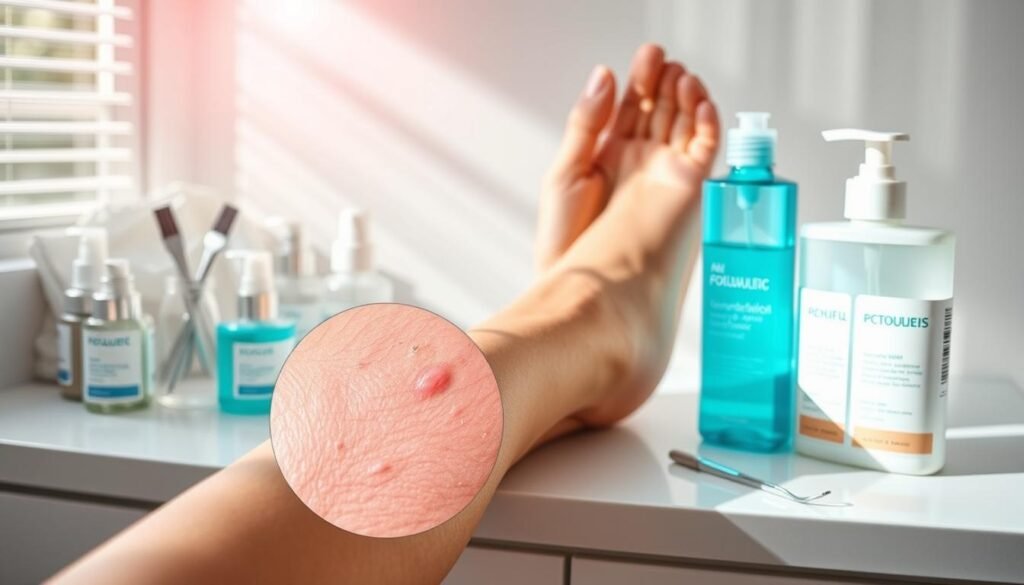Did you know about 20% of people with folliculitis on their legs need a doctor’s help? This infection is mostly caused by Staphylococcus aureus bacteria attacking hair follicles. It’s important to treat it early to feel better fast and stop worse problems.
In this article, we explore how to tackle staph folliculitis on legs. You’ll learn about home remedies, store-bought treatments, and when to see a doctor. Knowing about this condition helps manage the irritating itch and bumps it causes.
Key Takeaways
- Staph folliculitis targets leg hair follicles, needing medical care in 20% of cases.
- About 70% of mild cases improve with simple home remedies like warm compresses.
- Using antibacterial soaps and hydrocortisone creams eases itching and discomfort.
- For tougher cases, doctors might suggest antibiotics or laser hair removal.
- Good hygiene and proper clothing can greatly lower the chances of it coming back.
Understanding Staph Folliculitis on Legs
Staph folliculitis is a skin issue where hair follicles get infected, leading to red bumps or pustules. These can sometimes look like acne and often appear on the legs. The main bacterium behind this is Staphylococcus aureus.
Knowing about this condition helps in dealing with it better. It’s usually caused by irritants, too much moisture, and wearing tight clothes. People with weak immune systems or those prone to bacterial infections face a higher risk. Diabetes, being overweight, having a weak immune system, and shaving often can also increase the risk.
Usually, staph folliculitis on the legs goes away on its own in a few days. However, knowing how to treat it can speed up recovery and prevent it from coming back. If the problem doesn’t go away or is very bad, seeing a doctor is a good idea.
- Common Causes: Bacterial infection, skin irritants, moisture
- Symptoms: Red bumps, pustules, itching
- Risk Factors: Diabetes, obesity, immunosuppression
| Condition | Pathogen | Treatment Options |
|---|---|---|
| Staph Folliculitis | Staphylococcus aureus | Topical antibiotics, warm compresses |
| Superficial Folliculitis | Various bacteria | Self-limiting, topical agents |
| Malassezia Folliculitis | Malassezia yeast | Oral antifungal agents |
Causes of Staph Folliculitis on Legs
The main cause of staph folliculitis on legs is the Staphylococcus aureus bacteria. It often leads to a skin infection called superficial bacterial folliculitis. This makes it a leading reason for skin infections around the world.
Many things can lead to staph folliculitis on the legs. Shaving can irritate the skin, making it more open to infection. Wearing tight clothes can trap moisture and help bacteria grow. Being in warm, wet places like hot tubs and pools can also cause infections.
People with weak immune systems may be more likely to get staphylococcus aureus folliculitis. Hot and humid weather can make the bacteria grow faster. This leads to more infections.
Knowing why staph folliculitis happens is key for those with symptoms. It helps them find ways to prevent and treat it.
Symptoms of Staph Folliculitis on Legs
Knowing the symptoms of staph folliculitis on your legs is key to early care. Many see clusters of small red bumps or pustules around hair follicles. This often leads to discomfort. They also feel itching and sensitivity where it’s visible, requiring careful attention.
These symptoms can get worse, turning into crusty sores or swollen areas. People might also feel pain in the infected spots. If it gets really bad, you could see pus-filled lumps or even lose hair in those places. This means it’s time to see a doctor.
Those who enjoy using hot tubs or similar activities could be at higher risk. Spotting these symptoms early is important for effective treatment of staph folliculitis.
Home Remedies for Staph Folliculitis
Some simple home remedies can manage mild staph folliculitis. These natural methods may ease the irritation and fight the infection. They are especially useful for treating staph infections on the legs. Using these remedies can speed up healing and calm irritated skin.
Warm Compress Applications
Putting a warm compress on the skin can lessen the pain of folliculitis. The warmth helps with drainage, cutting down on swelling. Just soak a cloth in warm water, squeeze out the extra, and hold it on your skin for 10-15 minutes. Doing this several times a day can bring more comfort.
Antibiotic Creams and Lotions
For staph folliculitis on legs, antibiotic creams or lotions are helpful. They stop the infection from spreading. Look for creams with clindamycin or metronidazole. Those ingredients are good against these kinds of bacterial infections. Applying these creams regularly, and keeping the skin clean and dry, can make a big difference.

Over-the-Counter Treatments
There are several over-the-counter options to treat staph folliculitis. They help with itching, swelling, and preventing more infection. These treatments make a big difference for those treating leg folliculitis.
Hydrocortisone Creams for Itching
Hydrocortisone creams are great for lessening itch and swelling from folliculitis. They soothe the skin and ease discomfort. When used regularly, they can greatly improve mild skin issues.
Antibacterial Soaps
Washing with antibacterial soaps keeps the skin clean. It removes bacteria that can make the condition worse. By choosing good antibacterial products, you can lower your chance of more infections and help your skin heal. To learn about more treatments like steroid lotions, check out steroid lotions and creams.
Professional Treatments for Staph Folliculitis
When home remedies don’t work, it’s time to seek professional help for staph folliculitis. Doctors often prescribe antibiotics, which can be creams or pills. This treatment attacks the bacteria causing the infection and helps heal the skin.
Prescription Antibiotics
Antibiotics are key for tougher cases. For example, dicloxacillin is given at 250 mg, four times a day. Cefadroxil, another choice, is dosed at 500 mg, twice daily. For certain infections, doctors may use ciprofloxacin, which is very effective. Remember to finish all your medicine to stop bacteria from becoming resistant.
Laser Hair Removal Options
For chronic folliculitis, laser hair removal can be a game-changer. It helps avoid irritation from shaving or waxing. Plus, you’ll enjoy smoother skin and less hair over time. Many prefer this method because it treats folliculitis and makes their skin look better.

Understanding staph folliculitis is important for anyone. Professionally treating staph folliculitis and maintaining good hygiene can improve your skin health significantly. To learn more about managing your scalp and skin health, click here.
| Treatment Type | Description | Doses and Administration |
|---|---|---|
| Dicloxacillin | First-line oral antibiotic for staph infections | 250 mg four times daily |
| Cefadroxil | Cephalosporin antibiotic effective for serious infections | 500 mg twice daily |
| Ciprofloxacin | Effective against gram-negative folliculitis | 400-500 mg twice daily |
| Laser Hair Removal | Minimizes hair follicle irritation and reduces recurrence | Treatment sessions vary; consult with a professional |
Importance of Self-Care in Managing Folliculitis
Self-care is vital for controlling staph folliculitis and preventing its outbreaks. Good hygiene habits can lower infection risks, helping to improve your skin’s health. Simple actions can make a big difference in skin condition.
Maintaining Good Hygiene Practices
To keep folliculitis in check, start by washing the affected areas with mild soap. This step removes bacteria and stops hair follicles from getting blocked. It’s crucial to:
- Wash legs daily with antibacterial soap.
- Pat the skin dry instead of rubbing, which can irritate the follicles.
- Apply a non-comedogenic moisturizer to keep the skin hydrated without aggravating the condition.
Choosing Appropriate Clothing
Choosing the right clothes can help ease staph folliculitis symptoms. Wearing loose and breathable clothes helps reduce moisture that bacteria love. For better skin health, consider:
- Choosing cotton or linen over synthetic materials to promote breathability.
- Avoiding tight clothes that may cause friction and skin irritation.
- Wearing clean clothing daily to prevent the buildup of bacteria and oil on the skin.
Using these self-care tips is key to dealing with folliculitis well. Focusing on hygiene and comfort helps lead to healthier skin. This can also lower the chances of future outbreaks.
Preventing Recurrence of Staph Folliculitis on Legs
To prevent staph folliculitis on legs, focus on proper hair removal. Using the right shaving methods is crucial to lessen irritation and infection risk. Always use clean, sharp blades for a smooth shave. Avoid shaving over irritated skin to prevent making it worse. Let the skin heal completely before shaving again.
Shaving and Hair Removal Tips
Trying different hair removal options can also decrease skin irritation. Here are some tips for hair removal:
- Consider using a quality electric razor, which often leads to less irritation compared to traditional razors.
- Apply a soothing shaving cream or gel to provide a protective layer for your skin.
- Experiment with depilatory creams designed for sensitive skin, which may help avoid razor burns.
- Maintain consistent hygiene practices by cleansing the skin before and after shaving to reduce bacterial growth.
Making these changes is a big help in preventing staph folliculitis on legs. Managing your skin’s care through thoughtful hair removal minimizes the chance of infections returning. For more tips on stopping skin infections, check out this research on ways to tackle recurrent cases here.

When to Seek Medical Attention
Folliculitis might look minor, but it’s important to know when to see a doctor. This helps avoid worse problems. If it gets painful, doesn’t get better, or gets worse, you should see a doctor. Look out for a lot of pus, swelling, or fever. These signs mean the infection could be serious.
Some staph infection symptoms that require attention include:
- Red, painful bumps with hair in the center
- Pus-filled lesions that don’t heal
- Persistent or worsening pain
- Fever with other symptoms
Seeing a dermatologist early can help a lot. It often means better treatment options. This can prevent long-lasting inflammation or infections that need surgery. If you have diabetes or take certain meds, be extra careful. You could get infections more often.
For more info on what causes this and the symptoms, check out this informative resource. Watching your symptoms and knowing when to get help is key for your skin’s health.
| Symptom | Action |
|---|---|
| Red bumps with pustules | Keep it clean, see someone if it gets worse |
| Persistent fever | Get medical help right away |
| Severe pain or swelling | Call a doctor for a check-up |
| Symptoms last over 2-3 days | See a dermatologist for the best treatment |
Conclusion
Staph folliculitis on the legs can cause discomfort and frustration. However, it’s often manageable with home remedies and professional care. Learning the causes, spotting symptoms, and self-care are key to handling it.
Simple steps like using warm compresses, antibiotic creams, and keeping clean help fight staph folliculitis on the legs. Many find these remedies quite effective.
Research shows we need more studies on treatment options and their effects on health. This includes how often the condition returns and life quality.
If someone suffers from stubborn or serious staph folliculitis, they should see a doctor. Professional advice and prescriptions might be necessary.
Knowing the right information and tactics, anyone can lessen staph folliculitis’s effects. Effective remedies and staying updated lead to healthier skin and better health. For more info, look at published studies on current treatments.
